Thegrader
On this page, you find all documents, package deals, and flashcards offered by seller THEGRADER.
- 661
- 0
- 0
Community
- Followers
- Following
661 items
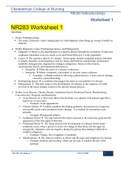
NR283 Worksheet 1
NR283 Worksheet 1 1. Define Pathophysiology. • The study of diseases; what is taking place (or what happens) when things go wrong; it builds on anatomy. 2. Define Diagnosis, Cause, Predisposing factors, and Pathogenesis. • Diagnosis Refers to the identification of a specific disease through the evaluation of signs and symptoms, laboratory tests (see inside cover and Ready Reference 5 in the Appendix). • Causes The causative factors of a disease. Some agents include congeni...
- Exam (elaborations)
- • 13 pages •
NR283 Worksheet 1 1. Define Pathophysiology. • The study of diseases; what is taking place (or what happens) when things go wrong; it builds on anatomy. 2. Define Diagnosis, Cause, Predisposing factors, and Pathogenesis. • Diagnosis Refers to the identification of a specific disease through the evaluation of signs and symptoms, laboratory tests (see inside cover and Ready Reference 5 in the Appendix). • Causes The causative factors of a disease. Some agents include congeni...

NR 283 Worksheet 2.
NR 283 Worksheet 2.
- Exam (elaborations)
- • 16 pages •
NR 283 Worksheet 2.
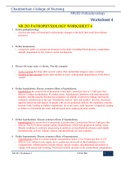
NR 283 PATHOPHYSIOLOGY WORKSHEET 4
NR 283 PATHOPHYSIOLOGY WORKSHEET 41. Define pathophysiology. - involves the study of functional or physiologic changes in the body that result from disease processes 2. Define homeostasis. - a relatively stable or constant environment in the body, including blood pressure, temperature, and pH, maintained by the various control mechanisms 3. Discuss the terms acute vs chronic. Provide examples. - Acute rejection develops after several weeks when unmatched antigens cause a...
- Exam (elaborations)
- • 23 pages •
NR 283 PATHOPHYSIOLOGY WORKSHEET 41. Define pathophysiology. - involves the study of functional or physiologic changes in the body that result from disease processes 2. Define homeostasis. - a relatively stable or constant environment in the body, including blood pressure, temperature, and pH, maintained by the various control mechanisms 3. Discuss the terms acute vs chronic. Provide examples. - Acute rejection develops after several weeks when unmatched antigens cause a...
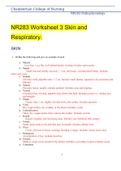
NR 283 Worksheet 3 Skin and Respiratory.
NR283 Worksheet 3 Skin and Respiratory. SKIN 1. Define the following:and give an example of each a. Macule Less than 1 cm, flat, well defined border. Includes freckles and measles. b. Papule Small firm and usually elevated, < 1 cm, solid mass, circumscribed border. Includes moles and warts c. Nodule Elevated, solid, palpable mass, 1-2 cm. Includes small lipoma, squamous cell carcinoma and fibroma. d. Pustule Elevated, lesion, usually contains ...
- Exam (elaborations)
- • 6 pages •
NR283 Worksheet 3 Skin and Respiratory. SKIN 1. Define the following:and give an example of each a. Macule Less than 1 cm, flat, well defined border. Includes freckles and measles. b. Papule Small firm and usually elevated, < 1 cm, solid mass, circumscribed border. Includes moles and warts c. Nodule Elevated, solid, palpable mass, 1-2 cm. Includes small lipoma, squamous cell carcinoma and fibroma. d. Pustule Elevated, lesion, usually contains ...

NR 283 Patho Final Exam Guide
NR 283 Patho Final Exam GuideCHAPTER 2: FLUID, ELECTROLYTE AND ACID-BASE BALANCE (5 questions) 1. EDEMA Increased capillary permeability 2. HYPOKALEMIA/HYPERKALEMIA -Cardiac dysrhythmias 3. PARATHYROID HORMONE (4 Scenarios) -produced in parathyroid gland which are four pea-sized glands that lie behind the thyroid gland -Calcium balance and phosphorus level is controlled by parathyroid hormone -Hypoparathyroidism can lead to hypocalcemia -Hyperparathyroidism can lead to hypercalcem...
- Exam (elaborations)
- • 12 pages •
NR 283 Patho Final Exam GuideCHAPTER 2: FLUID, ELECTROLYTE AND ACID-BASE BALANCE (5 questions) 1. EDEMA Increased capillary permeability 2. HYPOKALEMIA/HYPERKALEMIA -Cardiac dysrhythmias 3. PARATHYROID HORMONE (4 Scenarios) -produced in parathyroid gland which are four pea-sized glands that lie behind the thyroid gland -Calcium balance and phosphorus level is controlled by parathyroid hormone -Hypoparathyroidism can lead to hypocalcemia -Hyperparathyroidism can lead to hypercalcem...
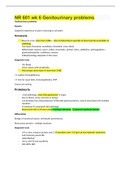
NR 601 wk 6 Genitourinary problems
NR 601 wk 6 Genitourinary problemsDysuria Subjective experience of pain or burning on urination Hematuria - Blood in urine; more than 3 RBC=> direct relationship to quantity of blood and the probability of pathology - Two types (Transient: sometimes, Persistent: more often) - Differentials: trauma, cancer, coffee, chocoholic, alcohol, citrus, antibiotics, anticoagulation, - glomerulonephritis, urolithiasis, menses - Pathophysiology-depends on the cause Diagnostic tests - UA: Blood - ...
- Exam (elaborations)
- • 12 pages •
NR 601 wk 6 Genitourinary problemsDysuria Subjective experience of pain or burning on urination Hematuria - Blood in urine; more than 3 RBC=> direct relationship to quantity of blood and the probability of pathology - Two types (Transient: sometimes, Persistent: more often) - Differentials: trauma, cancer, coffee, chocoholic, alcohol, citrus, antibiotics, anticoagulation, - glomerulonephritis, urolithiasis, menses - Pathophysiology-depends on the cause Diagnostic tests - UA: Blood - ...
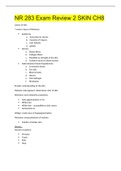
NR 283 Exam Review 2 SKIN CH8
NR 283 Exam Review 2 SKIN CH8Layers of skin: *varies in layer of thickness • Epidermis a. Avascular/no nerves b. Consists of 5 layers c. Hair follicles d. glands • Dermis a. Elastic fibers b. Collagen fibers c. Flexibility & strength of the skin d. Contains nerves & blood vessels • Subcutaneous tissue (hypodermis) a. Connective tissue b. Fat cells c. Blood vessels d. Nerves e. Macrophages f. fibroblasts Keratin: waterproofing of the skin Melanin: skin pigment- determine...
- Exam (elaborations)
- • 17 pages •
NR 283 Exam Review 2 SKIN CH8Layers of skin: *varies in layer of thickness • Epidermis a. Avascular/no nerves b. Consists of 5 layers c. Hair follicles d. glands • Dermis a. Elastic fibers b. Collagen fibers c. Flexibility & strength of the skin d. Contains nerves & blood vessels • Subcutaneous tissue (hypodermis) a. Connective tissue b. Fat cells c. Blood vessels d. Nerves e. Macrophages f. fibroblasts Keratin: waterproofing of the skin Melanin: skin pigment- determine...
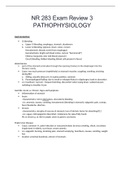
NR 283 Exam Review 3 PATHOPHYSIOLOGY| WITH RATIONALES
NR 283 Exam Review 3 PATHOPHYSIOLOGY Gastrointestinal • GI bleeding a. Upper GI bleeding: esophagus, stomach, duodenum b. Lower GI bleeding: jejenum, ileum, colon, rectum Hematemesis: bloody vomit (from esophagus) Hematochezia: bright-red blood (colon, rectum “hemmoroid”) Melena: burgundy color (old blood; jejunum) Occult bleeding: hidden bleeding (blood cells present in feces) Hiatal Hernia: • part of the stomach protrudes through the opening (hiatus) in the diaphragm into t...
- Exam (elaborations)
- • 14 pages •
NR 283 Exam Review 3 PATHOPHYSIOLOGY Gastrointestinal • GI bleeding a. Upper GI bleeding: esophagus, stomach, duodenum b. Lower GI bleeding: jejenum, ileum, colon, rectum Hematemesis: bloody vomit (from esophagus) Hematochezia: bright-red blood (colon, rectum “hemmoroid”) Melena: burgundy color (old blood; jejunum) Occult bleeding: hidden bleeding (blood cells present in feces) Hiatal Hernia: • part of the stomach protrudes through the opening (hiatus) in the diaphragm into t...
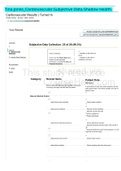
Tina.Jones_Cardiovascular.Subjective Data.Shadow Health.
Tina.Jones_Cardiovascular.Subjective Data.Shadow Health.
- Exam (elaborations)
- • 6 pages •
Tina.Jones_Cardiovascular.Subjective Data.Shadow Health.

Focused Exam: Cough Results | Completed A dvanced Health Assessment - January 2020,
Focused Exam: Cough Results | Completed A dvanced Health Assessment - January 2020,
- Exam (elaborations)
- • 21 pages •
Focused Exam: Cough Results | Completed A dvanced Health Assessment - January 2020,
